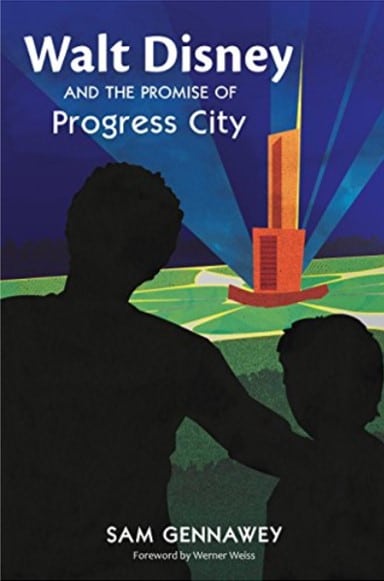Category — A Friday Visit with Jim Korkis
A Friday Visit with Jim Korkis: All-Star Movies
Welcome back to Fridays with Jim Korkis! Jim, the dean of Disney historians, writes about Walt Disney World history every Friday on yourfirstvisit.net.
THE ICONS OF DISNEY’S ALL-STAR MOVIES RESORT
By Jim Korkis
All-Star Movies was the third and final resort hotel to be completed in the All-Star Complex of value resorts that also includes All-Star Sports and All Star-Music. It features buildings themed to Disney movies.
The Mighty Ducks and 101 Dalmatians sections opened January 15, 1999, the Fantasia (based on both the original movie and its 2000 sequel) and Herbie: The Love Bug sections opened in March, and the final section, Toy Story, opened in April 1999.
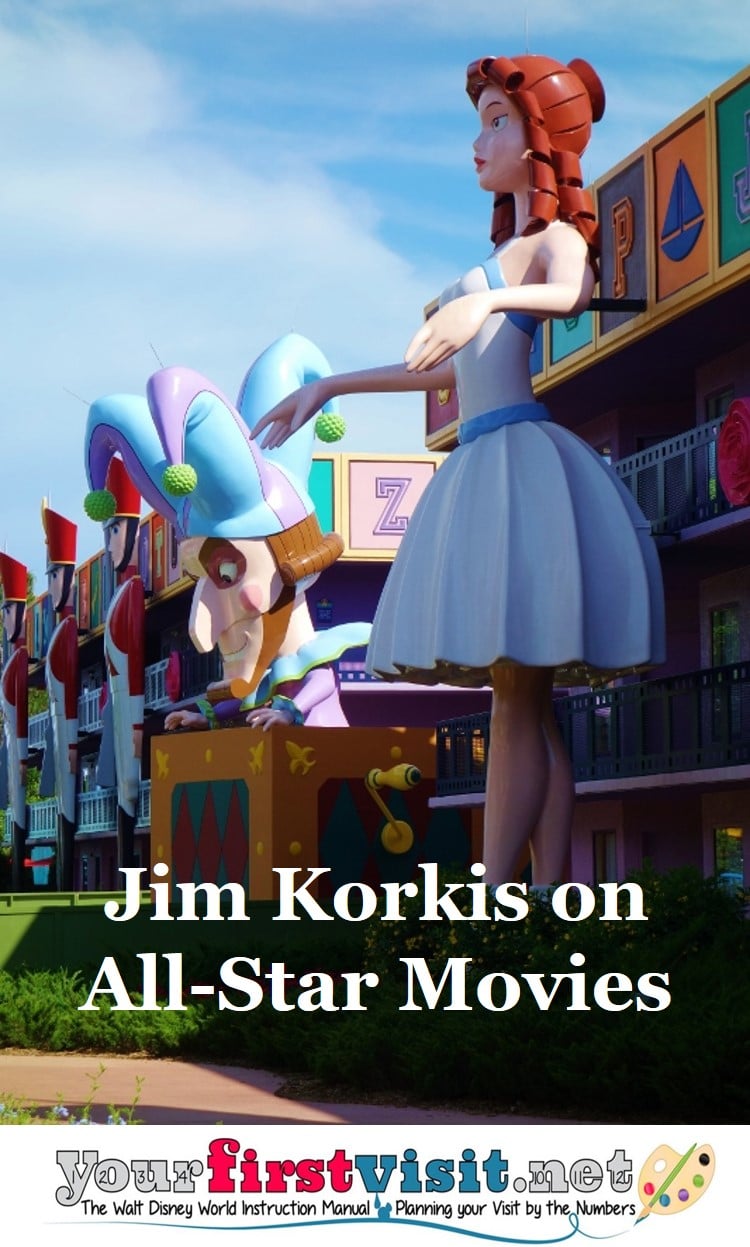
“The Dalmatians (Pongo and Perdita) are tall but thin. With Buzz Lightyear (forty-seven feet high and weighing thirty thousand pounds) you’ve got spindly legs topped by a Winnebago. You could literally have an apartment in his chest cavity,” said technical director for show production John Nelson.
“It is one of the biggest sculpted pieces Tujunga has ever done. Painting him in terms of time and materials was equivalent to painting fifteen cars.”
Pongo is forty feet tall and Perdita is thirty-five feet and their ninety-nine spotted puppies decorate the railings. There is a total of four miles of handrails on the buildings at the resort. Impressions of paw prints and dog bones are embedded in the cement walkways.
The building also cleverly features thirty-six foot high fire hydrants to imply that all those dogs have an outlet for relief.
Woody from Toy Story is only twenty-five feet high but the brim of his cowboy hat measures eighteen feet in diameter. There is a total of 142 Green Army Men with an average height of eight feet tall standing guard on two building rooftops and in the six Buckets O’Soldiers.
Eric Merz, who supervised the structural engineering for the icons, was especially fond of the thirty-six foot tall brooms from Fantasia that carried buckets. He recalled, “As far as taking an inanimate object like that, combining the engineering and making it come alive…Well, when the brooms and buckets got to the field and were all assembled, everyone took a breath and said, ‘wow’!”
The Fantasia section contains elements from the sequel Fantasia 2000 that wouldn’t be released until a year after the section opened, so special permission was required of Roy E. Disney, who among other titles was then chairman of Feature Animation and the producer of the film.
“It’s been a great lot of fun to watch these characters (from the sequel) get replicated in the size they are,” said Roy Disney. “The ballerina is such a pretty little thing in the movie – just a six-inch high doll. It’s fantastic to see her blown up to this giant size!”
Besides the ballerina, characters from that film included a jack-in-the-box and several toy soldiers.
Herbie is approximately five times his normal size and each car weighs seven tons with tires that are nine feet in diameter.
Imagineer John Hench designed several of the icons working with director of sculpting Valerie Edwards in producing the maquettes used for the final figures. Hench commented, “We use startling icons, beautifully finished in gutsy colors. People smile when they see them. It’s one of the magic elements of Disney Parks – engaging optimism.”
While the character icons were created at Tujunga, an additional sixty or so other objects were fabricated by outside contractors in Kansas City, Pittsburgh, Providence R.I., New Orleans, Los Angeles and even Orlando.
“There is no one in the country that has the capacity to build all of these,” stated construction manager Rob Brown.
* * * * *
Thanks, Jim! Images of almost all these icons are here. And come back next Friday for more from Jim Korkis!
In the meantime, check out his books, including his latest, Call Me Walt, and his Secret Stories of Walt Disney World: Things You Never You Never Knew, which reprints much material first written for this site, all published by Theme Park Press.
Follow yourfirstvisit.net on Facebook or Twitter or Pinterest!!
April 6, 2018 No Comments
A Friday Visit with Jim Korkis: Your Disney Library (4)
Welcome back to Fridays with Jim Korkis! Jim, the dean of Disney historians, writes about Walt Disney World history every Friday on yourfirstvisit.net.
YOUR DISNEY LIBRARY: WALT AND THE PROMISE OF PROGRESS CITY
By Jim Korkis
- Walt and the Promise of Progress City by Sam Gennawey
Today, Walt Disney World immediately conjures up an image of the Magic Kingdom and Cinderella Castle, but Walt Disney’s vision of WDW was of an international community of the future that showcased new technology and was to be a living laboratory of change.
Of course, there would be an entertainment venue similar to Disneyland, which became Magic Kingdom, but that was just to be a minor element of the overall plan and in fact, was shoved to the very top of the map on the very worst piece of land on the property.
Many books and articles have been written about how Walt’s original concept evolved into the familiar vacation destination that was focused on theme parks and resorts. One of the best is Sam Gennawey’s Walt and the Promise of Progress City .
It begins with the design of the Disney Studio and continues through everything from Walt’s backyard to Disneyland to CalArts to the Winter Olympics to World’s Fairs and more before even discussing the Florida Project.
In fact, half the book is devoted to those projects before exploring the idea of WDW. Sam approaches WDW not as a brief final vision of Walt Disney but as a natural outcome from decades of previous experiences in urban planning, so those early chapters serve as a fascinating roadmap to get to the final destination.
Sam’s writing is not only accessible to an average reader but also deeply researched, and provides a new perspective to familiar material.
Sam is also the author of two other books I recommend: Universal vs. Disney: The Unofficial Guide to American Theme Parks’ Greatest Rivalry and The Disneyland Story: The Unofficial Guide to the Evolution of Walt Disney’s Dream.
His professional training is as an urban planner where he has collaborated with California communities on more than a hundred different projects over the years. He brings that point of view to his writing about theme parks.
He is a senior associate at the planning firm of Katherine Padilla and Associates, and a member of the Board of Directors of the Los Angeles Regional Planning History Group, a nonprofit organization dedicated to preserving municipal, county, and private sector planning documents from throughout Los Angeles County.
So his approach at looking at Disney architecture and design is much different than the typical Disney writer looking at the same material, and is peppered with insights and quotes from urban planners like Christopher Alexander and architects and shows how those theories connect directly to Disney’s work.
One of the most intriguing chapters is a speculative visit to what Walt Disney World might have looked like if it had followed Walt’s initial planning. Of course, like any Disney project, it would have changed during the process but this is a nice glimpse of what Walt saw when he first proposed it.
He even interviewed Disney Legend Buzz Price who assures Sam that Walt’s vision of Epcot without hesitation would have worked but it would have taken a Walt Disney to make it happen. “Epcot would have been more famous than Walt Disney World,” Price tells Sam and explains why.
As Sam writes, “So the thirty story Cosmopolitan hotel in the center would have worked. The themed environment was basically Disneyland. The distance from the transportation center to the outer edge of the dome was less than 1,500 feet, which is two to three large city blocks – an easy, easy walk.
“Along the outer edges, he was going to create a critical mass of offices, and companies would have bellied up and put offices there just to be close to the Disney magic. Surrounded by that was apartments. So on a three-block walk was the critical mass of tourists in the center, full-time residents on the side and they all have to pass through each other. It is exactly what one wants when you want to build a city.”
* * * * *
Thanks, Jim! And come back next Friday for more from Jim Korkis!
In the meantime, check out his books, including his latest, Call Me Walt, and his Secret Stories of Walt Disney World: Things You Never You Never Knew, which reprints much material first written for this site, all published by Theme Park Press.
Follow yourfirstvisit.net on Facebook or Twitter or Pinterest!!
March 30, 2018 No Comments
A Friday Visit with Jim Korkis: Indiana Jones Adventure Outpost
Welcome back to Fridays with Jim Korkis! Jim, the dean of Disney historians, writes about Walt Disney World history every Friday on yourfirstvisit.net.
THE INDIANA JONES ADVENTURE OUTPOST
By Jim Korkis
The Indiana Jones Epic Stunt Spectacular opened on at what is now Disney’s Hollywood Studios on August 25, 1989, the same year the film Indiana Jones and The Last Crusade was released to theaters. In 2004, Nazi swastikas were removed from costuming and props and were replaced by a stylized Greek Cross.
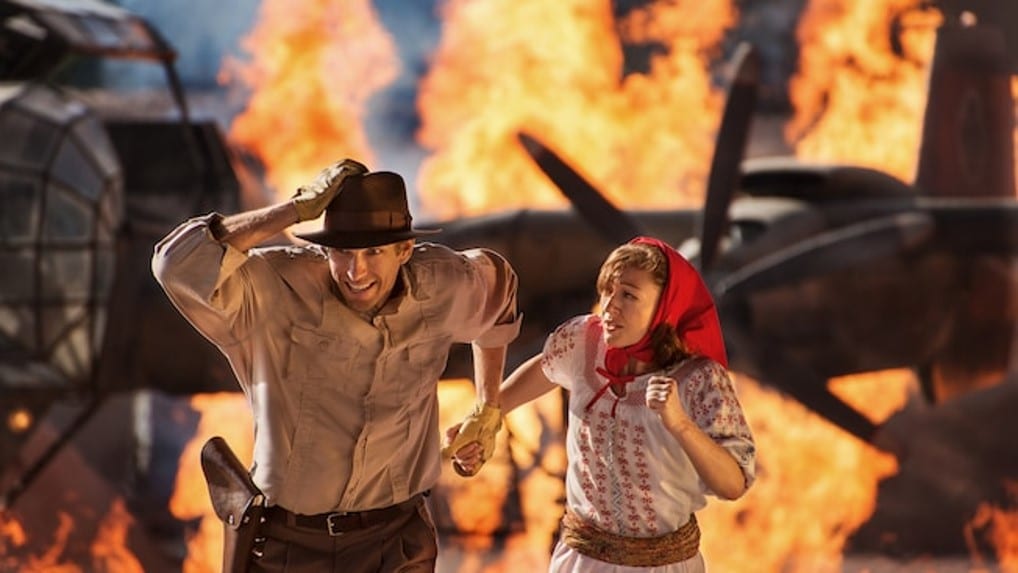
(c) Disney
At the exit of the attraction is a merchandise location called the Indiana Jones Adventure Outpost. The plans for the stunt show always included some type of souvenir venue but originally it was going to be a re-creation of Indiana Jones’ pre-World War II suburban Chicago house filled with artifacts from his many expeditions.
Another proposal was to have a Ford tri-motor airplane as an eating area adjoining a small merchandise shop but that was also abandoned.
“We had to come up with an idea that thematically fit the left block building which meant that one side had to look like Hollywood buildings in the 1930s but the other side had to fit the Indiana Jones story,” said Imagineering concept architect Joe Kilanowski.
“So we came up with a house in Hollywood that has one side propped and dressed to look like it is being used for a movie that takes place in the Middle East. The front of the building looks like a normal house but the other side looks like an outpost.”
To tie-in with the film, the outpost was meant to be a location where Indiana’s crew sets out to find the Holy Grail. To aid in that illustion, Disney acquired from Lucasfilm the tank, two trucks and two cars from Indiana Jones and the Last Crusade. The vehicles were meant to be part of a motor pool that were parked waiting for mechanics to work on them. To reinforce that concept, a fuel dump and machine gun nest (to protect the vehicles from being stolen or sabotaged) were added.
For the interior of the building, not just the Indiana Jones’ films served as inspiration. The Imagineers studied a number of films with a foreign legion theme like Beau Geste (1939) to achieve a sense of the appropriate time with period maps of the Middle East, old rifles, scimitars and barracks-type furniture.
The interior designer was Kate Zovich, who said “Instead of doing normal merchandise fixtures, we really wanted to accentuate the theme. Usually when an attraction has an annexed shop, the function of the shop takes precedence over the theming.
“But we wanted to go the whole nine yards with the Outpost and I think we succeeded. We put together old gun cases and hung shirts off of them. We actually modified half of a wing from a biplane in order to hang clothes.”
Imagineer Arden Ashley purchased many of the props that decorate the building. He noted of the exit from the attraction that “The landscaping and architecture work so well together. The exterior really draws your eye and the landscaping points you right into the shop.”
Senior concept designer Tim Kirk explained, “When people exit out of the stunt show, they go right past all this stuff. It’s a great way to sell merchandise because their blood is boiling after seeing the show and they want to buy something. The Outpost sells hats, videos, postcards, jewelry and leather jackets – some pretty nice stuff.”
Over the last two and half decades, the offerings expanded to pins, fedora hats and pith helmets, t-shirts, mugs, figures featuring Mickey Mouse as Indiana Jones and much more. A Disneyland version of the merchandise shop opened in March 1995 but was removed in 2017 to be repurposed as a new indoor seating area attached to the nearby Bengal Barbecue.
* * * * *
Thanks, Jim! And come back next Friday for more from Jim Korkis!
In the meantime, check out his books, including his latest, Call Me Walt, and his Secret Stories of Walt Disney World: Things You Never You Never Knew, which reprints much material first written for this site, all published by Theme Park Press.
Follow yourfirstvisit.net on Facebook or Twitter or Pinterest!!
March 23, 2018 No Comments
A Friday Visit with Jim Korkis: The Old New Fantasyland
Welcome back to Fridays with Jim Korkis! Jim, the dean of Disney historians, writes about Walt Disney World history every Friday on yourfirstvisit.net.
THE NEW FANTASYLAND OF 2009
By Jim Korkis
Sometimes Walt Disney World announces upcoming attractions with great fanfare and detailed concept art, but several factors can prevent those dreams from becoming a reality. On September 12, 2009 at the D23 Expo held at the Anaheim Convention Center in California, then Walt Disney Parks and Resorts Chairman Jay Rasulo revealed detailed plans for a massive expansion of WDW’s Fantasyland that would open in 2012 and be completed by 2013.
Rasulo told an eager crowd: “There have been a lot of rumors online, and I don’t know where they come from, and I don’t even know where they get started, but it’s about a big expansion of Fantasyland at Walt Disney World.
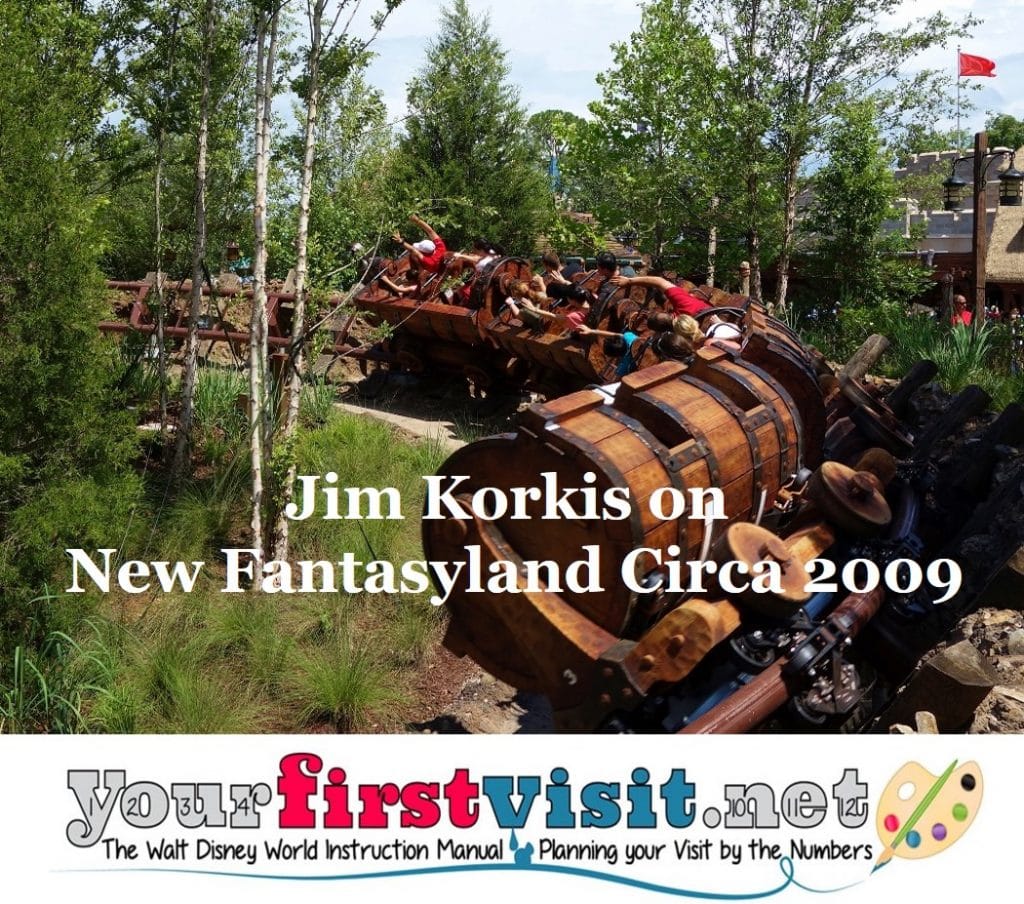
“Now those visits are going to be more entertaining than ever. You’ll meet Disney princesses in their own fairy tale worlds. You’ll be immersed in the sights, the sounds and the magic that make every princess story so memorable.”
With the continuing success of the Disney Princess franchise that started in 2008, the expansion would emphasize these popular Disney characters in order to synergize with merchandise sales.
Cinderella’s country chateau would be where she lives with her stepmother and stepsisters in a forest setting. At the Cinderella Chateau, guests would have observed the Fairy Godmother magically prepare Cinderella for the royal ball and then guests would be able to share a dance to prepare for the ball.
At the Sleeping Beauty Cottage, participants would have helped celebrate Briar Rose’s surprise sweet sixteen birthday party with the help of the good fairies Flora, Fauna and Merryweather. Among other things guests would make birthday cards for the princess and then greet her with a big surprise.
Belle would host a “comical retelling” of her story with the Beast in her father’s cottage.
In addition, Dumbo would be moved to brand new circus grounds and expand into two spinning attractions. Be Our Guest would be an elaborate dining facility with multiple rooms in Beast’s castle. Under the Sea: Journey of The Little Mermaid would be similar to the one being built for Disney’s California Adventure and would also feature a meet-and-greet location with Ariel.
Tinker Bell and her fairy friends would reside in Pixie Hollow where guests would shrink to the size of a pixie and play among towering blades of grass and flowers.
Concerns from fans that the additions were too “girl-centric” resulted in Disney making some changes while retaining some of the originally announced items when Tom Staggs, who had three young sons, replaced Rasulo.
“One of the things that I thought the early design did fantastically was delivered on that princess experience. And that does tend to skew toward girls. We’ve kept that intact – not exactly necessarily the way it was presented – but that appeal is there,” Staggs told the Orlando Sentinel in August 2010. “I think we’ve added some things that aren’t just princess-focused, and that’s a good positive.”
The Snow White Seven Dwarfs Mine Train took the place of the princess cottages and Storybook Circus took over the area for Pixie Hollow. However, the concept of Princess meet-and-greets was retained with the creation of the Princess Fairytale Hall and Enchanted Tales with Belle.
When the plans were significantly changed for the area, there was discussion to move Pixie Hollow over to Epcot as part of the Flower and Garden Festival or to find a more permanent home according to The Orlando Sentinel newspaper at Disney’s Hollywood Studios to tie-in to the Tinker Bell animated films. Neither happened.
* * * * *
Thanks, Jim! And come back next Friday for more from Jim Korkis!
In the meantime, check out his books, including his latest, Call Me Walt, and his Secret Stories of Walt Disney World: Things You Never You Never Knew, which reprints much material first written for this site, all published by Theme Park Press.
Follow yourfirstvisit.net on Facebook or Twitter or Pinterest!!
March 16, 2018 No Comments
A Friday Visit with Jim Korkis: Voyage of the Little Mermaid
Welcome back to Fridays with Jim Korkis! Jim, the dean of Disney historians, writes about Walt Disney World history every Friday on yourfirstvisit.net.
VOYAGE OF THE LITTLE MERMAID AT DISNEY’S HOLLYWOOD STUDIOS
By Jim Korkis
Voyage of the Little Mermaid is a multimedia indoor stage show at Disney’s Hollywood Studios that incorporates live performers, character costumes, a variety of puppets, water effects, lasers, a huge animation screen backdrop, and more, to immerse audiences into an approximately fifteen minute re-telling of the popular Disney animated feature The Little Mermaid (1989).
Here Come the Muppets ran in the same Animation Courtyard Theater from May 25, 1990, to September 2, 1991. The device utilized for that show to have the front of a monorail crash onto stage with the Muppets and later retract is the same one used now to move Ariel’s rock.
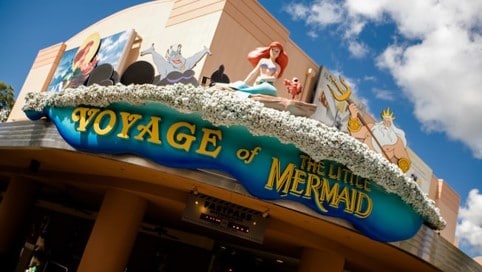
(C) Disney
The Voyage of The Little Mermaid was meant to be a temporary placeholder show, designed to last perhaps two years. It was only budgeted at approximately five and half million dollars.
The director was Fran Soeder, who also directed The Legend of the Lion King puppet show at the Magic Kingdom and The Hunchback of Notre Dame show at the Studios, among many other accomplishments. Once the show was up and running, Michael Korkis took over as maintenance director for the next five years.
In the pre-show, low-ceilinged (to help establish a feeling of going under the sea) waiting area, guests are surrounded by a nautical theme and many clever artifacts including one of Captain Nemo’s diving suits and a peg leg worn by L.J. Silver (the pirate Long John Silver from Disney’s live action feature Treasure Island).
King Triton’s trident hangs on the wall leading into the theater and glows when it is time to enter. The Heffelginger Brain Coral is a reference to Jim Heffelfinger who was the General Manager of Entertainment at WDW.
Ariel is a live performer with a microphone attached to her wig so that she actually sings. The performer has previously recorded a safety track so if during a show she experiences vocal problems, she can lip sync if needed. All the other singing in the show is pre-recorded.
The original Ariel was performed by Leanza Cornett, who eventually became Miss Florida and then later Miss America in 1993.
She was hired for the role in November 1991 along with Michelle Martin and a singer from the northeast named Jenny to cover all the shows. Even though Cornett won the pageant in September 1992 and left the role, she feared she would be unable to find a job after her reign so came back during her Easter break in 1993 to do the role again to keep her character status. She went on to be one of the hosts on Entertainment Tonight in 1994.
Miss Tampa, Nicole Padgett, a senior at University of South Florida majoring in psychology, who won the Miss Florida crown in 1993, also portrayed Ariel during the summer of 1993.
Originally, Ariel sat down in a hole on that big clam shell on a bicycle seat with pedals so she could manipulate the tail. That is not the case today.
There are over a hundred different puppets in the Under the Sea musical number with puppeteers responsible for some puppets connected together. The puppeteers are clothed completely in black so when the black light is on, the audience only sees the movement of the characters.
The Ursula puppet is impressively twelve feet tall and ten feet wide, and while her head turns, her tentacles have limited mobility.
The attraction went through a significant rehab in 2004. In 2007, there were rumors of the attraction closing so as not to be in conflict with the upcoming Broadway production based on the animated feature. However, the attraction continues to consistently bring in so many guests that it remained open.
* * * * *
Thanks, Jim! And come back next Friday for more from Jim Korkis!
In the meantime, check out his books, including his latest, Call Me Walt, and his Secret Stories of Walt Disney World: Things You Never You Never Knew, which reprints much material first written for this site, all published by Theme Park Press.
Follow yourfirstvisit.net on Facebook or Twitter or Pinterest!!
March 9, 2018 No Comments
A Friday Visit with Jim Korkis: Coronado Springs
Welcome back to Fridays with Jim Korkis! Jim, the dean of Disney historians, writes about Walt Disney World history every Friday on yourfirstvisit.net.
CORONADO SPRINGS: THE LEGEND OF JUAN FRANCISCO
By Jim Korkis
Spanish explorer Francisco de Coronado left Mexico in 1540 and headed north in search of the fabled seven golden cities of Cibola. Imagineers used that story as a springboard to create a resort that would reflect the textures, colors and art of both Mexico and the American Southwest.
When the moderate resort Coronado Springs opened at Disney World in August 1997, the Imagineers said that the back story was that “Coronado Springs was founded by the descendants of a Spanish explorer named Juan Francisco. Searching for gold in 1569, Francisco stumbled upon the ruins of a forty-six foot tall Mayan pyramid.
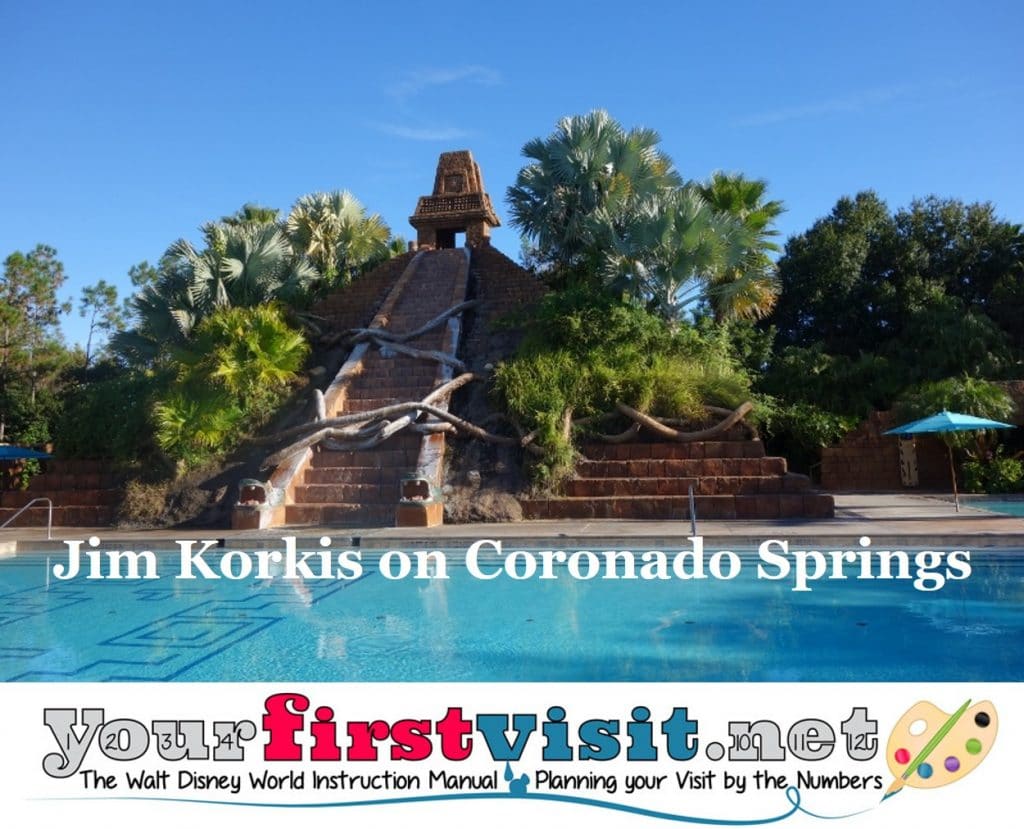
Wing Chao, then senior vice president of Master Planning and Architecture, said “We looked at a map to see where people go on vacation. After determining that they like to go to Mexico and the Southwestern United States, we just blended the themes.”
The project was put on hold several times for a variety of reasons after it was first proposed in 1992. The original plans did not include a convention center, but new studies showed that Walt Disney World did not have enough convention space. Moreover, those Disney World resorts that already had convention space had room rates too high for some associations’ budgets.
With the adoption of tunnel form construction with poured concrete bays, it became economically feasible to provide convention space and moderately priced rooms. The Coronado ballroom is roughly 60,214-square-foot and is the largest ballroom in the southeastern United States.
The resort was designed to reflect three themes: Cabanas, Ranchos and Casitas. The two story Cabana buildings represent the coastal regions of the American Southwest and Gulf Coast villas. The Cabanas surround the rocky beach adjacent to the fifteen acre man-made lake, Lago Dorado.
The architecture and landscape of the Ranchos suggest the more arid, country-ranch or farmhouse parts of the region with a small stream or arroyo tumbling over a rocky stream bed. Project coordinator Mark Kohl said, “We made sure the vegetation selected would really grow next to a river in the same region of Mexico.”
The Casitas were inspired by the urban areas of Mexico and the American Southwest. The Casitas are interspersed with colorful plazas and fountains and palm-shaded courtyards.
“We had to find a balance between Mexico and the Southwest when it came to selecting colors and how they relate,” said Kohl. “It was a two year research process where team members went to look and bring back photos, art and books for inspiration. I have a Mexican stone calendar on my wall. The art we finally selected for the guest rooms provides a better fit for the theme of that particular area.”
Palacios are decorated in shades of desert sand and sunset pink. The red tile roofs, mosaic accents, shady courtyards and sunny patios recall the grand haciendas of the Spanish Colonial era.
Project coordinator Cindy MacKenzie returned from a research trip to Oaxaca with three foot tall frogs, lobsters and iguanas to take up residence in the 420 seat Pepper Market food court meant to suggest an old warehouse where individual food vendors have set up shop. The restaurant is divided into three areas: the fire temple near the exhibit cooking, the water temple and the sun temple.
A new 15-story tower overlooking Lago Dorado, the resort’s central lake, will add 500 rooms featuring suites and concierge level services, and a rooftop dining facility that will include panoramic views of nighttime fireworks shows at the Disney World parks. At the same time, a room refurb project is about half done, and there are also plans to transform some of Coronado Springs’ landscape.
* * * * *
Thanks, Jim! There’s more on Coronado Springs here. And come back next Friday for more from Jim Korkis!
In the meantime, check out his books, including his latest, Call Me Walt, and his Secret Stories of Walt Disney World: Things You Never You Never Knew, which reprints much material first written for this site, all published by Theme Park Press.
Follow yourfirstvisit.net on Facebook or Twitter or Pinterest!!
March 2, 2018 No Comments



